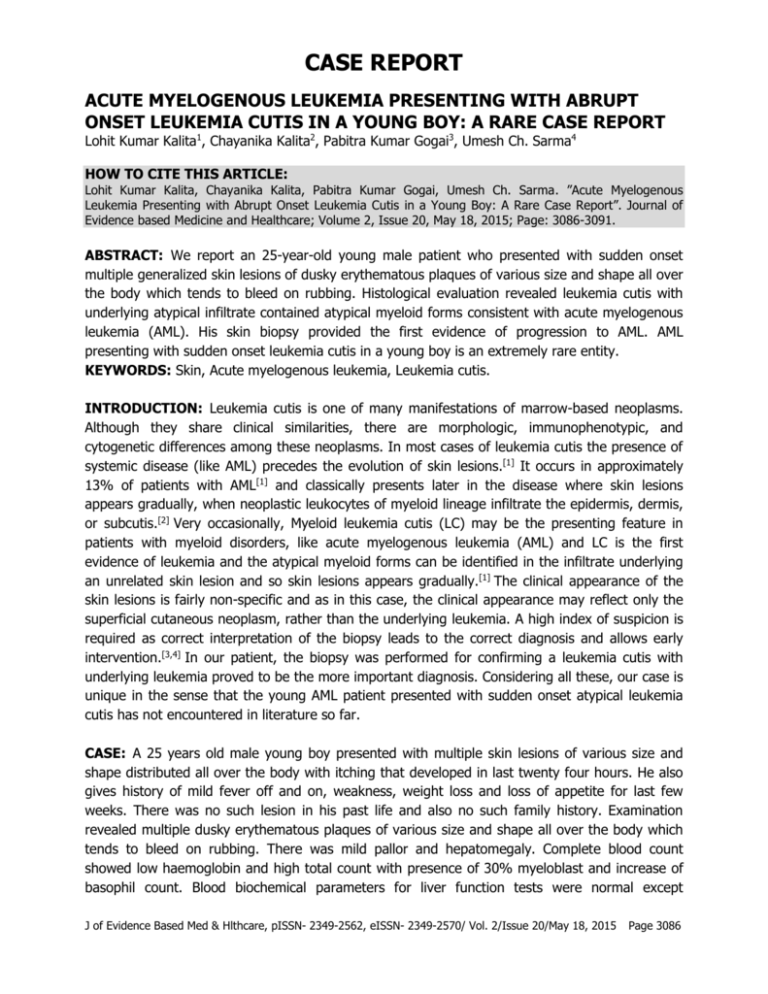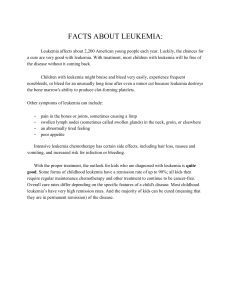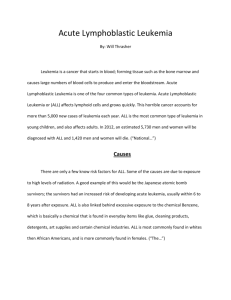acute myelogenous leukemia presenting with abrupt onset leukemia
advertisement

CASE REPORT ACUTE MYELOGENOUS LEUKEMIA PRESENTING WITH ABRUPT ONSET LEUKEMIA CUTIS IN A YOUNG BOY: A RARE CASE REPORT Lohit Kumar Kalita1, Chayanika Kalita2, Pabitra Kumar Gogai3, Umesh Ch. Sarma4 HOW TO CITE THIS ARTICLE: Lohit Kumar Kalita, Chayanika Kalita, Pabitra Kumar Gogai, Umesh Ch. Sarma. ”Acute Myelogenous Leukemia Presenting with Abrupt Onset Leukemia Cutis in a Young Boy: A Rare Case Report”. Journal of Evidence based Medicine and Healthcare; Volume 2, Issue 20, May 18, 2015; Page: 3086-3091. ABSTRACT: We report an 25-year-old young male patient who presented with sudden onset multiple generalized skin lesions of dusky erythematous plaques of various size and shape all over the body which tends to bleed on rubbing. Histological evaluation revealed leukemia cutis with underlying atypical infiltrate contained atypical myeloid forms consistent with acute myelogenous leukemia (AML). His skin biopsy provided the first evidence of progression to AML. AML presenting with sudden onset leukemia cutis in a young boy is an extremely rare entity. KEYWORDS: Skin, Acute myelogenous leukemia, Leukemia cutis. INTRODUCTION: Leukemia cutis is one of many manifestations of marrow-based neoplasms. Although they share clinical similarities, there are morphologic, immunophenotypic, and cytogenetic differences among these neoplasms. In most cases of leukemia cutis the presence of systemic disease (like AML) precedes the evolution of skin lesions.[1] It occurs in approximately 13% of patients with AML[1] and classically presents later in the disease where skin lesions appears gradually, when neoplastic leukocytes of myeloid lineage infiltrate the epidermis, dermis, or subcutis.[2] Very occasionally, Myeloid leukemia cutis (LC) may be the presenting feature in patients with myeloid disorders, like acute myelogenous leukemia (AML) and LC is the first evidence of leukemia and the atypical myeloid forms can be identified in the infiltrate underlying an unrelated skin lesion and so skin lesions appears gradually.[1] The clinical appearance of the skin lesions is fairly non-specific and as in this case, the clinical appearance may reflect only the superficial cutaneous neoplasm, rather than the underlying leukemia. A high index of suspicion is required as correct interpretation of the biopsy leads to the correct diagnosis and allows early intervention.[3,4] In our patient, the biopsy was performed for confirming a leukemia cutis with underlying leukemia proved to be the more important diagnosis. Considering all these, our case is unique in the sense that the young AML patient presented with sudden onset atypical leukemia cutis has not encountered in literature so far. CASE: A 25 years old male young boy presented with multiple skin lesions of various size and shape distributed all over the body with itching that developed in last twenty four hours. He also gives history of mild fever off and on, weakness, weight loss and loss of appetite for last few weeks. There was no such lesion in his past life and also no such family history. Examination revealed multiple dusky erythematous plaques of various size and shape all over the body which tends to bleed on rubbing. There was mild pallor and hepatomegaly. Complete blood count showed low haemoglobin and high total count with presence of 30% myeloblast and increase of basophil count. Blood biochemical parameters for liver function tests were normal except J of Evidence Based Med & Hlthcare, pISSN- 2349-2562, eISSN- 2349-2570/ Vol. 2/Issue 20/May 18, 2015 Page 3086 CASE REPORT moderate high of total billirubin. Kidney function test were normal. Ultrasonography of whole abdomen revealed subacute intestinal obstruction, ascites, bilateral pleural effusion (left > right), hepatomegaly and bulky left kidney with UB Debris. Bone marrow aspiration examination showed more than 60% myeloblasts. Flow Cytometry of bone marrow aspirate demonstrated total leukocyte count – 1,24,900/ul with 75% blasts and suggestive of Acute Myeloid Leukemia, AMLM0. Skin biopsy of the lesions demonstrated leukemia cutis with an underlying dermal infiltrate of immature myeloid cells (Figure 3 & 4). Immunohistochemical staining for myeloperoxidase, CD68 and CD34 supported a diagnosis of myelogenous leukemia. DISCUSSION: Leukemia cutis is the infiltration of malignant neoplastic leukocytes or their precursors into the epidermis, dermis, or subcutis that most commonly results in red to purple papules, nodules, or hemorrhagic ulcers. Although lesions of leukemia cutis can occur in any location, the areas most commonly involved are the head, neck, and trunk.[5] But in our cases the involvement was generalized. There are several types of leukemia, each with its own epidemiologic characteristics. Acute lymphoblastic leukemia most commonly is seen in children; AML and chronic myelogenous leukemia primarily are seen in adults, and chronic lymphocytic leukemia and hairy cell leukemia characteristically are seen in elderly patients.[5] But in our case Leukemia cutis developed in a very young boy. Accurate diagnosis has tremendous prognostic importance, especially in cases of aleukemic leukemia cutis in which skin lesions present prior to any systemic leukemic process. The pathogenesis of acute myelogenous leukemia is unclear; however, there is strong evidence in epidemiologic studies suggesting that environmental, occupational, and genetic factors play an important role in its development. The diagnosis rests on the recognition of immature myeloid cells within the cutaneous infiltrate. The cells commonly demonstrate hyperchromasia, amphophilic cytoplasm and a tendency toward single filing between collagen bundles. Nuclear molding may be noted. Any myeloid cell line may be represented, including immature neutrophils, eosinophils or basophils. Epidermal changes are usually minimal, but may be the most prominent finding in cases such as ours when the biopsy is performed because of the overlying unrelated skin lesion. In our case, histopathological examination of skin lesion suggested infiltration of immature myeloid cells. The malignant cell in AML is a blast that most often expresses myeloid or monocytic differentiation; however, blasts also may express erythroid or megakaryocytic differentiation. Cytogenetic analysis has demonstrated that as much as 50% of patients with AML subtypes M4 (acute myelomonocytic leukemia) and M5 (acute monocytic leukemia) develop leukemia cutis. Karyotypic analysis of these subtypes demonstrates t(8;21)(translocation of chromosomes 8 and 21). In our case, the Immunohistochemical staining for myeloperoxidase, CD68 and CD34 supported a diagnosis of myelogenous leukemia. Although the precise molecular basis for developing leukemia cutis is still not defined, this knowledge will assist in defining the factors responsible for its manifestation.[6] Acute myelogenous Leukemia may present as an isolated papule or nodule, but the manifestations may be as diverse as an erythematous, pruritic, morbilliform eruption or patches and plaques mimicking mycosis fungoides.[7] Our patient presented with multiple dusty pleomorphic plaques. Leukemic cells may also be recruited to areas of inflammation.[8] The clinical differential diagnosis J of Evidence Based Med & Hlthcare, pISSN- 2349-2562, eISSN- 2349-2570/ Vol. 2/Issue 20/May 18, 2015 Page 3087 CASE REPORT of leukemia cutis includes benign lymphocytoma cutis, sarcoidosis, Sweet disease, urticarial vasculitis, hypereosinophilic syndrome, cutaneous metastatic carcinoma, neutrophilic eccrine hidradenitis, drug eruptions, drug-induced gingival hyperplasia, erythema nodosum, and pyoderma gangrenosum. A diagnosis of leukemia cutis in the presence of acute myelogenous Leukemia is a poor prognostic indicator and strongly correlates with additional sites of extramedullary involvement.[9] This can alter the appropriate treatment regimen for a patient, making the diagnosis of particular importance. Patients presenting with leukemia cutis in association with non-melanoma skin cancer have including those with squamous cell carcinoma and basal cell carcinomas.[10] In view of the above, out case is a rare one because Leukemia cutis developed in our patient who is a very young boy; skin lesions of Leukemia Cutis developed suddenly within twenty four hours; skin biopsy revealed it to be typical myeloid Leukemia Cutis with infiltration of immature myeloid cells. In our patient, the overlying epidermal changes were diagnostic of leukemia cutis and it might have been easy to overlook the more important diagnosis of leukemia. CONCLUSION: Leukemia cutis is a local manifestation of an underlying systemic process; therefore, treatment should be directed at eradicating the leukemic clone by using systemic chemotherapy. Dermatologist and dermatopathologists need to remain sensitive to the possibility of a critical diagnosis within the infiltrate underlying a common cutaneous lesion. A diagnosis of leukemia cutis in the presence of acute myelogenous Leukemia is a poor prognostic indicator and strongly correlates with additional sites of extramedullary involvement. So this case serves as an important reminder of the role the dermatologist, Oncologist and dermatopathologist who can play important role in early identifying the serious systemic disease so that early intervention can be taken to treat such patients and thereby minimizing complications. REFERENCES: 1. Baer MR, Barcos M, Farrell H, Raza A, Preisler HD. Acute myelogenous leukemia with leukemia cutis. Eighteen cases seen between 1969 and 1986. Cancer 1989; 63: 2192-200. 2. Rao AG, Danturty I. Leukemia cutis. Indian J Dermatol 2012; 57: 504. 3. Cibull TL, Thomas AB, O'Malley DP, Billings SD. Myeloid leukemia cutis: A histologic and immunohistochemical review. J Cutan Pathol 2008; 35: 180-5. 4. Misri R, Khopkar U, Kharkar V, Mahajan S. Different faces of leukemia cutis: Presenting as purpura fulminans and lupus like butterfly rash. Indian J Dermatol Venereol Leprol 2010; 76: 710-2. 5. Smoller B. Other lymphoproliferative and myeloproliferative diseases. In: Bolognia JL, Jorizzo JL, Rapini RP, eds. Dermatology. Philadelphia, PA: Mosby; 2003: 1943-1952. 6. Lowenberg B, Downing JR, Burnett A. Acute myeloid leukemia. N Engl J Med. 1999; 341: 1051-1062. 7. Gibney MD, Penneys NS, Nelson-Adesokan P. Cutaneous eruption of lymphocyte recovery mimicking mycosis fungoides in a patient with acute myelocytic leukemia. J Cutan Pathol 1995; 22: 472-5. J of Evidence Based Med & Hlthcare, pISSN- 2349-2562, eISSN- 2349-2570/ Vol. 2/Issue 20/May 18, 2015 Page 3088 CASE REPORT 8. Bakst RL, Tallman MS, Douer D, Yahalom J. How I treat extramedullary acute myeloid leukemia. Blood 2011; 118: 3785-93. 9. Cho-Vega JH, Medeiros LJ, Prieto VG, Vega F. Leukemia cutis. Am J Clin Pathol 2008; 129: 130-42. 10. Ra S, Su A, Ellison D, Koperski J, Bonilla M, Robbins B. Leukemia cutis in association with cutaneous epidermal malignancies. J Cutan Pathol 2012; 39: 971-6. Fig. 1: The patient with multiple dusky erythematous plaques of various size and shape over the front side of trunk and abdomen. Fig. 1 Fig. 2: The patient with multiple dusky erythematous plaques of various size and shape over the back side of trunk and abdomen. Fig. 2 J of Evidence Based Med & Hlthcare, pISSN- 2349-2562, eISSN- 2349-2570/ Vol. 2/Issue 20/May 18, 2015 Page 3089 CASE REPORT Fig. 3: AML with Cutaneous infiltration: Histopathology of skin biopsy shows focal infiltration of the sub epidermis and superficial dermis by immature myeloid cells suggesting seconday leukemic infiltration of skin (10X). Fig. 3 Fig. 4: AML with Cutaneous infiltration. Histopathology of skin biopsy shows focal infiltration of the sub epidermis and superficial dermis by atypical Myeloid cells suggesting seconday leukemic infiltration of skin. The skin immediately above the myeloid aggregates (show pressure atrophy magnification: (40X)) Fig. 4 J of Evidence Based Med & Hlthcare, pISSN- 2349-2562, eISSN- 2349-2570/ Vol. 2/Issue 20/May 18, 2015 Page 3090 CASE REPORT AUTHORS: 1. Lohit Kumar Kalita 2. Chayanika Kalita 3. Pabitra Kumar Gogai 4. Umesh Ch. Sarma PARTICULARS OF CONTRIBUTORS: 1. Assistant Professor, Department of Oncology, Gauhati Medical College, Guwahati, Assam, India. 2. Assistant Professor, Department of Dermatology, Gauhati Medical College, Guwahati, Assam, India. 3. Professor & HOD (Rtd), Department of Clinical Haematology, Gauhati Medical College & Hospital, Guwahati, Assam, India. 4. Vice-Chancellor, Srimanta Sankaradeva University of Health Sciences, Narakasur Hill Top, Guwahati, Assam, India. NAME ADDRESS EMAIL ID OF THE CORRESPONDING AUTHOR: Dr. Lohit Kumar Kalita, Department of Oncology, Gauhati Medical College, Guwahati, Assam. E-mail: lkkalita2013@gmail.com Date Date Date Date of of of of Submission: 05/05/2015. Peer Review: 06/05/2015. Acceptance: 11/05/2015. Publishing: 18/05/2015. J of Evidence Based Med & Hlthcare, pISSN- 2349-2562, eISSN- 2349-2570/ Vol. 2/Issue 20/May 18, 2015 Page 3091





